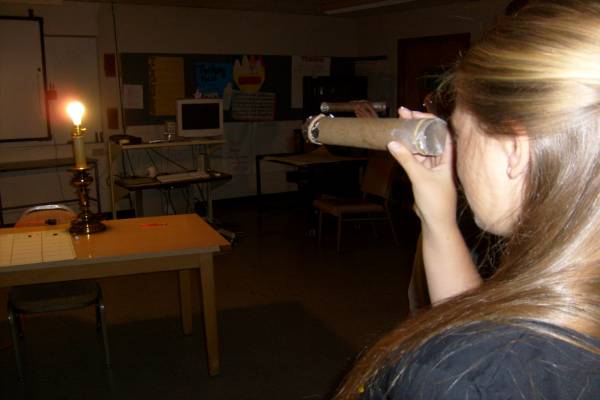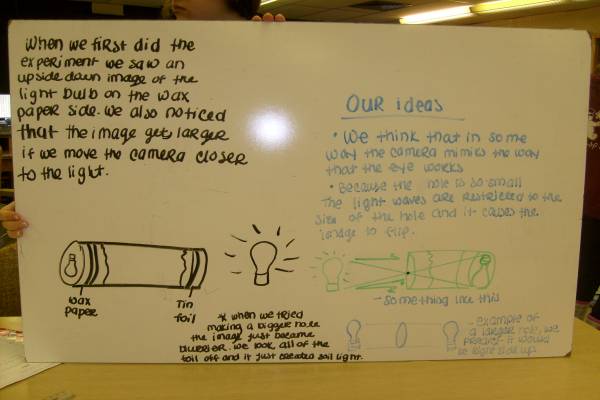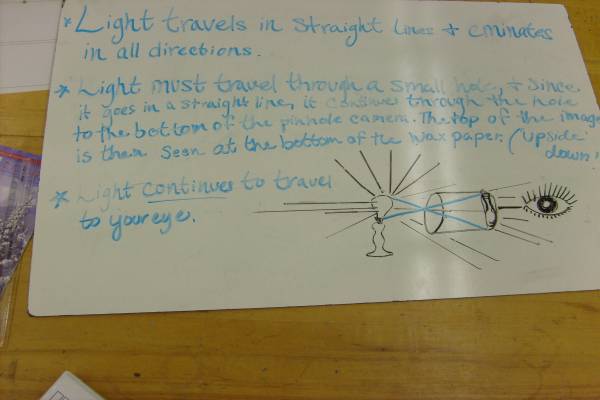You are here: start » activities » sun_earth_moon » pinholecameras
Pinhole Cameras
Navigation Link
Assembly of the Pinhole Cameras
Photographers use pinhole cameras to capture images without a lens. They use a light-proof box with a small hole on the side to allow light to enter from the objects they are photographing. In Physics 111, the students create their very own pinhole cameras to further explore light phenomena. To assemble pinhole cameras, they take a toilet paper roll, a small sheet of wax paper, a small sheet of aluminum foil, rubber bands, and a paper clip. The students fastened the wax paper to one end of the toilet paper role with a rubber band and they fastened the aluminum foil to the other end with a rubber band. Afterward, the students poked a small hole in the center of the aluminum foil with the paper clip. It looked something like this:
 |
Turn on the lamp, what do you see?
The students held their pinhole cameras up and pointed them at the light source (a light bulb). They pointed the aluminum foil end (the side with the small hole) at the light bulb while they looked through the wax paper end. Upon holding up their pinhole cameras, they observed a fascinating scientific phenomenon! An image of the light bulb appears on the wax paper, upside down! The students were amazed. They immediately started asking questions of how and why this was possible.
 |
Conversations about Why
The students began processing the pinhole phenomena by:
| Writing down their observations | Writing down the powerful ideas they had already generated about light |
|---|---|
 |  |
Scientific Explanation
The students knew that 1.) Light travels in straight lines. 2.) Light leaves a light source from all points and travels in all directions.
They drew pictures of what they were observing to try and understand the phenomena. They drew straight lines coming off of the light bulb in all directions. They also drew their pinhole cameras with a small hole. In doing so, the students realized that some of the straight lines they were drawing must inevitably enter the small hole in the toilet paper roll. Since light only travels in straight lines, the students discovered that the light rays leaving the bulb could not go straight through the tube unless they first went through the hole in the center of the aluminum foil. Thus, the light rays that were leaving the bottom of the light bulb traveled in a straight line through the hole to the top of the wax paper, while the light rays that were leaving the top of the light bulb traveled in a straight line through the hole to the bottom of the wax paper.
The image of the light bulb appeared flipped because the light rays had to travel through a tiny hole to reach the wax paper. This is different than how our eyes interpret what a light bulb normally looks like without a pinhole camera because light rays from every spot on the light bulb can reach our eyes from every angle.
We call these pinhole cameras even though we are not taking pictures. To capture an image, a photographer would place film where we placed the wax paper.
Reflections/ Student Notebook Pages During an Exploration of Light and Pinhole Cameras
As usual, at the end of the day in Physics 111, the students wrote about their science experiences and discoveries to reflect upon their learning. Here is one example of a student's reflections on her notebook pages. Notice the connections she draws between pinhole cameras and the moon in the “What am I still curious about” section. This student's highlighting denotes the important ideas within her reflection. One of the graduate teaching assistants instructed the students to denote what they felt was important within their notebook pages.
 |  |